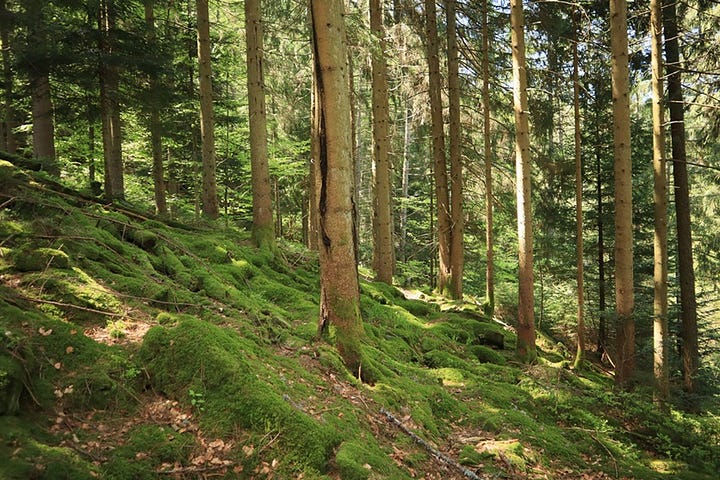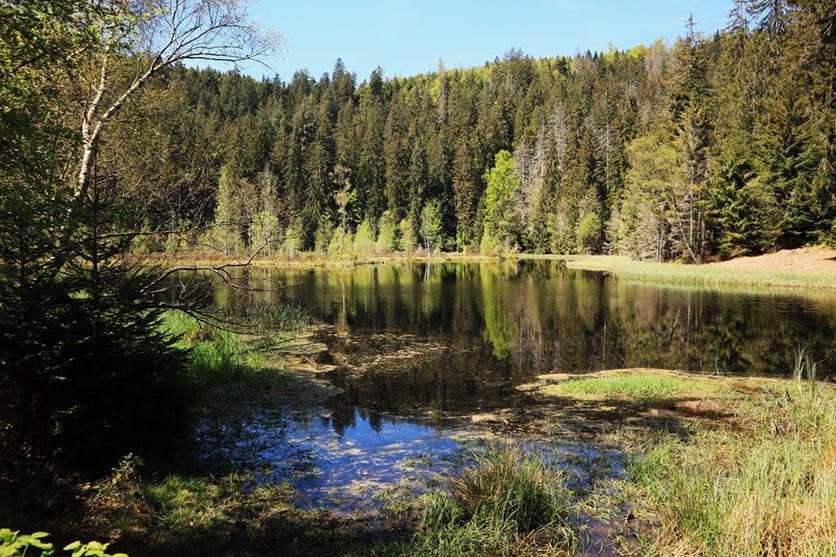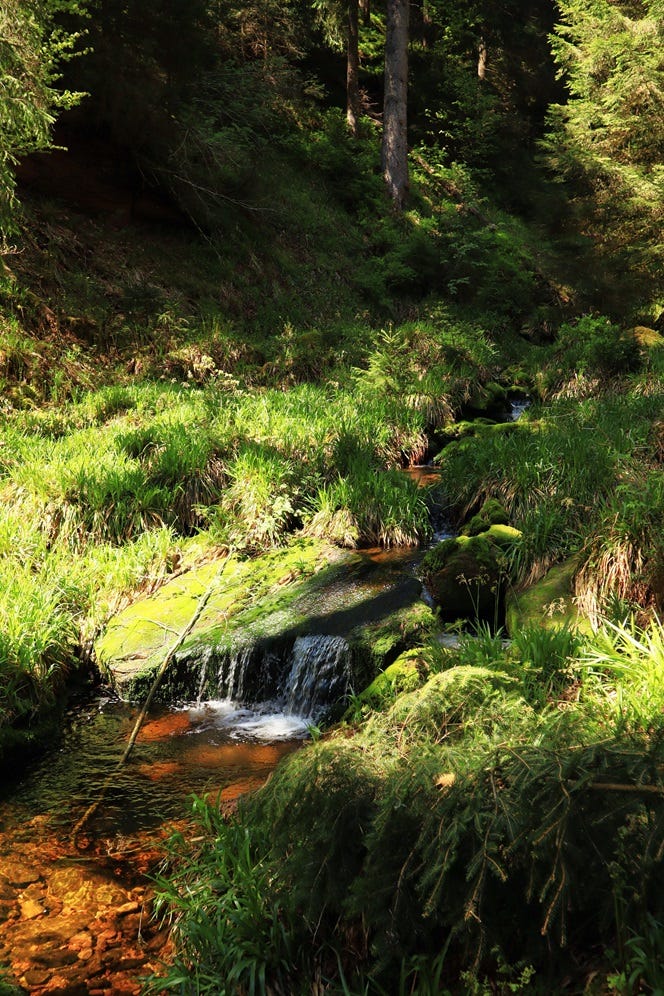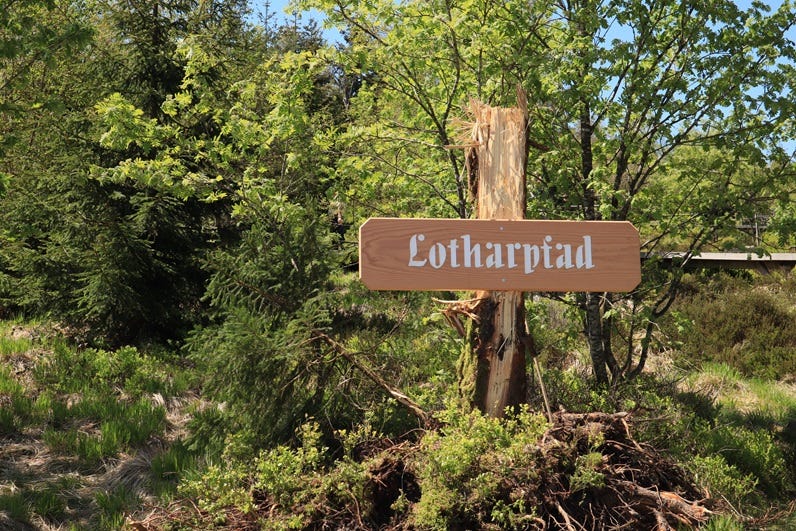On 26 December 1999, the “storm of the century” hit south-west Germany with a 200 km/hour rage (locally even above 250). It was called Hurricane Lothar. Forty thousand hectares of forest were devastated, and thirty million cubic metres of wood were hurled around like dice.
In the past I have come a few times, on my hikes, to places where Hurricane Lothar was mentioned on info boards. The landscape still looked bald, where former forests were hacked short, and tree trunks stood like sticks, bleached by the sun and weather.
It may be hard to believe, but in such places apparently the mountain used to be covered by forests.
I wanted to see one of these places where the landscape was changed radically by Lothar, and where a non-intervention site has been set up: the humans leave the nature to recover by itself. Visitors can see for themselves, and walk around on narrow wooden piers, without trampling on the protected biotope.
It’s called Lothar’s Path.
I’ve avoided it so far because it’s terribly crowded, they say. It’s one of the top five attractions in the northern Black Forest, but today I’m lucky. I can take as many pictures I like.
I leave my car at the Zuflucht sports hotel (965m altitude), and go into the woods. It’s a light, airy and eerie evergreen forest, with a narrow trail paved by stones and roots, and the floor overgrown with thick moss and heath. Today, as I walk through, also dappled with plenty of sunlight.


The forest soon opens up into a valley, where I come to the shore of a glacial lake, rimmed by grasses. In its middle, a moor island.
I carry on heading for Lothar’s Path, through young woods, where the multitude of greens strikes me again and again. A gurgling stream runs along the path.
And soon, here I am. No mountains to see: I’m on the peak. No woods around: Lothar’s new landscape, a bald alpine thicket with bolder evergreens and young beech trees spearing up here and there.
And here it is: the wooden trails to contain the visitors and remind them that they’re just that, visitors.
The labyrinth of paths take me across heath areas, past observation “balconies”. In one segment, the path is set higher, and you feel as if you’re walking in the air, among tree tops. In another, you descend into the thicket on adventure paths, up and down and roundabout, over boulders, up on panorama platforms.




And yet, one question forms itself gradually in my mind.
Where are Lothar’s traces?
And that’s the point. There are no traces. The devastation has been replaced by a new landscape.
Still, if you look closely, you may still get clues, such as long-rotten tree stumps.
But this is what Lothar’s Path has made me think about: no devastation is permanent.
Lothar’s Path is a disaster story. Or is it?
Isn’t it more a restoration story?
A life-death-life story.
A loss-transformation story. Have, have not, gain something else story.
But let me be clear: I’m not talking about nature’s cycle of recovery. This isn’t worth “discovering” and reflecting on, as it’s long been evident. No, I’m talking about people’s ability to replace a disaster with a restoration story.
I was part of a discussion circle recently about women in the Bible, and we inevitably came to the myth of Adam and Eve. I lamented the fact that other civilisations have genesis myths that celebrate life, fertility, the bounty of Mother Earth, while we, Christians, see our world originating from sin. From separation. From loss.
I’m thinking now, separation and loss might be part of the universal cycle after all, and if so, they might need to be part of a creation myth; but the full story is only complete with the restoration.
So here it is, Hurricane Lothar: it came, it destroyed, it created. The post-Lothar landscape.
But the truly marvellous bit is that the people here have created a new story out of the devastation it left behind. This mountain peak has become one of the highlights in the national park. A forest once, it’s now a unique site to marvel at.
The trees were swept off? Okay. What have we got left? Let’s give it a story and celebrate it.
Who said creation was done?













Zoe, this is very thought provoking and the photos are great. Wouldn't it be great if we could internalize "Have, have not, gain something else story" as you say. Rock on!
Very interesting, Zoe. Thanks. I've often wondered how nature would heal even larger wounds, such as entire cities. More a thought experiment than an actual desire to see civilization go away.
Specific to Lothar and the spirit of non-intervention, I can't help but think that true non-intervention wouldn't involve building wooden paths and balconies, wouldn't involve taking an act of nature and turning it into a tourist attraction.
But, even a tourist attraction is an act of creation, I suppose. It's different though, a reactionary creation. And destruction, too, is an act of creation. And though I understand that's it's frequently not possible, I wonder if we could just leave things be at times.